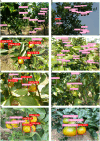Fusion of fruit image processing and deep learning: a study on identification of citrus ripeness based on R-LBP algorithm and YOLO-CIT model
- PMID: 38903428
- PMCID: PMC11188418
- DOI: 10.3389/fpls.2024.1397816
Fusion of fruit image processing and deep learning: a study on identification of citrus ripeness based on R-LBP algorithm and YOLO-CIT model
Abstract
Citrus fruits are extensively cultivated fruits with high nutritional value. The identification of distinct ripeness stages in citrus fruits plays a crucial role in guiding the planning of harvesting paths for citrus-picking robots and facilitating yield estimations in orchards. However, challenges arise in the identification of citrus fruit ripeness due to the similarity in color between green unripe citrus fruits and tree leaves, leading to an omission in identification. Additionally, the resemblance between partially ripe, orange-green interspersed fruits and fully ripe fruits poses a risk of misidentification, further complicating the identification of citrus fruit ripeness. This study proposed the YOLO-CIT (You Only Look Once-Citrus) model and integrated an innovative R-LBP (Roughness-Local Binary Pattern) method to accurately identify citrus fruits at distinct ripeness stages. The R-LBP algorithm, an extension of the LBP algorithm, enhances the texture features of citrus fruits at distinct ripeness stages by calculating the coefficient of variation in grayscale values of pixels within a certain range in different directions around the target pixel. The C3 model embedded by the CBAM (Convolutional Block Attention Module) replaced the original backbone network of the YOLOv5s model to form the backbone of the YOLO-CIT model. Instead of traditional convolution, Ghostconv is utilized by the neck network of the YOLO-CIT model. The fruit segment of citrus in the original citrus images processed by the R-LBP algorithm is combined with the background segment of the citrus images after grayscale processing to construct synthetic images, which are subsequently added to the training dataset. The experiment showed that the R-LBP algorithm is capable of amplifying the texture features among citrus fruits at distinct ripeness stages. The YOLO-CIT model combined with the R-LBP algorithm has a Precision of 88.13%, a Recall of 93.16%, an F1 score of 90.89, a mAP@0.5 of 85.88%, and 6.1ms of average detection speed for citrus fruit ripeness identification in complex environments. The model demonstrates the capability to accurately and swiftly identify citrus fruits at distinct ripeness stages in real-world environments, effectively guiding the determination of picking targets and path planning for harvesting robots.
Keywords: LBP feature; citrus; deep learning; image processing; ripeness identification.
Copyright © 2024 Wang, Han, Li, Zou and Zou.
Conflict of interest statement
The authors declare that the research was conducted in the absence of any commercial or financial relationships that could be construed as a potential conflict of interest.
Figures















Similar articles
-
"Is this blueberry ripe?": a blueberry ripeness detection algorithm for use on picking robots.Front Plant Sci. 2023 Jun 9;14:1198650. doi: 10.3389/fpls.2023.1198650. eCollection 2023. Front Plant Sci. 2023. PMID: 37360727 Free PMC article.
-
Fruits hidden by green: an improved YOLOV8n for detection of young citrus in lush citrus trees.Front Plant Sci. 2024 Apr 10;15:1375118. doi: 10.3389/fpls.2024.1375118. eCollection 2024. Front Plant Sci. 2024. PMID: 38660450 Free PMC article.
-
CAM-YOLO: tomato detection and classification based on improved YOLOv5 using combining attention mechanism.PeerJ Comput Sci. 2023 Jul 20;9:e1463. doi: 10.7717/peerj-cs.1463. eCollection 2023. PeerJ Comput Sci. 2023. PMID: 37547387 Free PMC article.
-
A Comprehensive Review of Deep Learning in Computer Vision for Monitoring Apple Tree Growth and Fruit Production.Sensors (Basel). 2025 Apr 12;25(8):2433. doi: 10.3390/s25082433. Sensors (Basel). 2025. PMID: 40285123 Free PMC article. Review.
-
Non-Destructive Banana Ripeness Detection Using Shallow and Deep Learning: A Systematic Review.Sensors (Basel). 2023 Jan 9;23(2):738. doi: 10.3390/s23020738. Sensors (Basel). 2023. PMID: 36679535 Free PMC article. Review.
Cited by
-
YOLO-ALW: An Enhanced High-Precision Model for Chili Maturity Detection.Sensors (Basel). 2025 Feb 25;25(5):1405. doi: 10.3390/s25051405. Sensors (Basel). 2025. PMID: 40096232 Free PMC article.
-
ASD-YOLO: a lightweight network for coffee fruit ripening detection in complex scenarios.Front Plant Sci. 2025 Feb 10;16:1484784. doi: 10.3389/fpls.2025.1484784. eCollection 2025. Front Plant Sci. 2025. PMID: 39996111 Free PMC article.
-
Intelligent Detection of Tomato Ripening in Natural Environments Using YOLO-DGS.Sensors (Basel). 2025 Apr 23;25(9):2664. doi: 10.3390/s25092664. Sensors (Basel). 2025. PMID: 40363103 Free PMC article.
-
YOLOv8-Scm: an improved model for citrus fruit sunburn identification and classification in complex natural scenes.Front Plant Sci. 2025 Jul 7;16:1591989. doi: 10.3389/fpls.2025.1591989. eCollection 2025. Front Plant Sci. 2025. PMID: 40692672 Free PMC article.
References
-
- Beyaz A., Gül V. (2023). YOLOv4 and tiny YOLOv4 based forage crop detection with an artificial intelligence board. Braz. Arch. Biol. Technology. 66, e23220803. doi: 10.1590/1678-4324-2023220803 - DOI
-
- Brown C. (1998). “Coefficient of variation,” in Applied Multivariate Statistics in Geohydrology and Related Sciences, 155–157. doi: 10.1007/978-3-642-80328-4 - DOI
-
- Chen W., Lu S., Liu B., Chen M., Li G., Qian T. (2022). CitrusYOLO: A algorithm for citrus detection under orchard environment based on YOLOv4. Multimed. Tools Appl. 81, 31363–31389. doi: 10.1007/s11042-022-12687-5 - DOI
-
- Fang W., Wang L., Ren P. (2019). Tinier-YOLO: A real-time object detection method for constrained environments. IEEE Access 8, 1935–1944. doi: 10.1109/Access.6287639 - DOI
LinkOut - more resources
Full Text Sources
Miscellaneous

